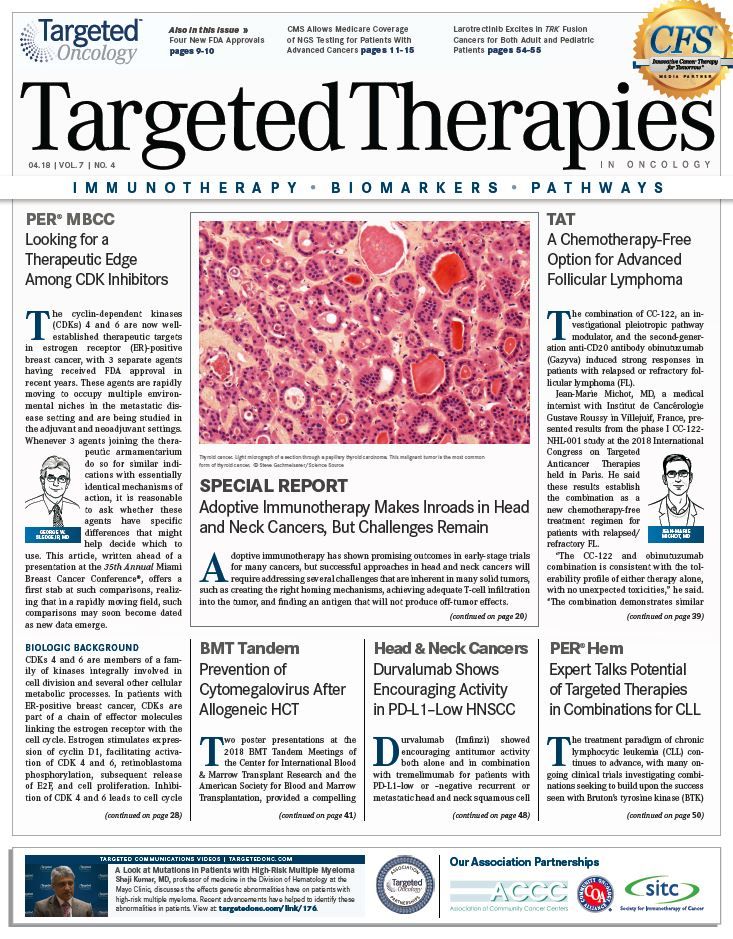Shingrix Prevents Herpes Zoster Episodes Following HSCT
A herpes zoster subunit vaccine effectively prevented episodes of HZ and other related complications among patients who had recently underwent autologous hematopoietic stem cell transplant, according to the results of the phase III ZOE-HSCT trial presented at the 2018 BMT Tandem Meetings.
Shingrix reduced the risk of HZ by 68.2% (95% CI, 55.6%-77.5%; P <.0001) in high-risk recipients of HSCT. Improvements were also noted in cases of postherpetic neuralgia, HZ-related hospitalizations, and other complications, noted lead author Javier de la Serna, MD, PhD, of the Hospital Universitario 12 de Octubre in Madrid, Spain.
“Administered to adults early after autologous hematopoietic stem cell transplant, the herpes zoster subunit vaccine effectively prevented herpes zoster, independent of age, and postherpetic neuralgia,” de la Serna et al wrote in their abstract. “The safety profile of the herpes zoster vaccine subunit in this population was clinically acceptable.”
In the randomized, observer-blind, placebo-controlled phase III study, patients were randomized 1:1 to either the HZ subunit vaccine (n = 922) or placebo (n = 924). All patients had received autologous HSCT 50 to 70 days prior to the start of treatment and were followed for at least a year, as risk for HZ is highest in the first year after transplant.
The recombinant adjuvanted subunit vaccine, which contains recombinant varicella zoster virus (VZV) glycoprotein E and the AS01B adjuvant system, was administered intramuscularly in the deltoid region of the nondominant arm in 2 doses spaced 1 to 2 months apart.
Patients were also divided into 2 cohorts. The total population, which included those who received ≥1 dose of the vaccine and were analyzed for safety, was included in the total vaccinated cohort (TVC) and those who had not received dose 2 or who developed HZ less than 1 month after the second dose were included in the modified TVC (mTVC) cohort.
The modified cohort included 1721 patients: 870 treated with the vaccine and 851 treated with placebo. A majority of these patients (75.3%) were ≥50 years. Approximately half (54.4%) had multiple myeloma, and the remainder had other underlying diseases necessitating stem cell transplant.
In the overall population, baseline characteristics were well balanced between the 2 arms. The mean age at first dose was 54.8 years in the investigational arm and 55.1 years in the control arm. The majority of the patients (62.7%) were male.
The primary objective of the study was vaccine efficacy in the mTVC cohort as assessed by episodes of HZ, which were confirmed by polymerase chain reaction assay. At a median follow-up of approximately 21 months, 49 patients (5.6%) treated with Shingrix had an episode of HZ compared with 135 (15.9%) in the placebo arm.
Cases of postherpetic neuralgia were experienced by 1 patient treated with the vaccine compared with 9 in the placebo arm, amounting to a vaccine efficacy of 89.3% (95% CI, 22.5%-99.8%). Other HZ complications were experienced by 3 and 13 patients, respectively, in the treatment and placebo arms, for an efficacy of 77.8% (95% CI, 19.1%-95.9%). Hospitalizations due to HZ were experienced by 2 patients in the vaccine arm compared with 13 in the placebo arm, leading to an efficacy of 84.7% (95% CI, 32.2%-96.6%) for the vaccine.
When looking at the patient population 50 years or older, HZ was experienced by 40 patients who were treated with Shingrix versus 106 who received placebo (vaccine efficacy, 67.3%; 95% CI, 52.6%- 77.9%). In the younger patient population, there were 9 episodes of HZ with the vaccine and 29 with placebo (vaccine efficacy, 71.8%; 95% CI, 38.8%-88.3%).
In both age groups in the TVC cohort, incidence of local and general solicited adverse events (AEs) was more frequent in the investigational arm (85.8% local; 42.1% general) compared with placebo (10.4% local; 16.8% general), which de la Serna noted was expected. Grade 3 local events were experienced by 14.2% in the experimental arm compared with 0.3% in the control arm, and grade 3 general events were experienced by 7.8% and 1.0%, respectively.
The most common local solicited AEs, which occurred within 7 days after each dose, included injection-site pain (any-grade, 83.9% vs 9.3% with placebo), redness (33.4% vs 1.0%), and swelling (18.6% vs 1.0%). Common general AEs included fatigue (56.4% vs 38.0%), gastrointestinal AEs (26.4% vs 20.5%), headache (33.5% vs 18.6%), myalgia (53.7% vs 26.2%), shivering (26.3% vs 12.9%), and fever (20.3% vs 5.6%).
Serious AEs, which occurred up to 1 year after the second dose, were experienced by 28.5% of those treated with Shingrix compared with 26.1% treated with placebo. Of these serious AEs, 0.3% and 0.4%, respectively, were considered related to treatment, and 12.8% and 13.4% were fatal.
Relapses were experienced by 25.9% of patients who received the HZ subunit vaccine and 27.4% who received placebo.
Reference:
de la Serna J, Campora L, Chandrasekar P, et al. Efficacy and safety of an adjuvanted herpes zoster subunit vaccine in autologous hematopoietic stem cell transplant recipients 18 years of age or older: first results of the phase 3 randomized, placebo-controlled ZOE-HSCT clinical trial. Presented at: 2018 BMT Tandem Meetings; February 21-25, 2018; Salt Lake City, UT. Abstract LBA2. bmt.confex.com/tandem/2018/meetingapp.cgi/Paper/11724.

Survivorship Care Promotes Evidence-Based Approaches for Quality of Life and Beyond
March 21st 2025Frank J. Penedo, PhD, explains the challenges of survivorship care for patients with cancer and how he implements programs to support patients’ emotional, physical, and practical needs.
Read More